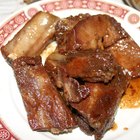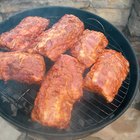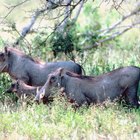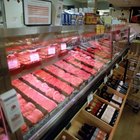
When it comes to oven-baking ribs, there are two schools of thought. The first method is to braise the ribs covered with some liquid until they're tender, followed by a brief blast of high heat to caramelize them. The second is to sear the ribs first and then give them a long, slow cooking time. In both cases, you cover the ribs for part of the cooking time to prevent them drying out. Either method works as long as you use low heat and allow several hours for the ribs to become tender.
Slow From Go
To braise ribs, place a rack on a baking sheet and place the ribs directly on the rack. Add a bit of liquid, such as apple juice or water, to the bottom of the pan. Cover the ribs on the rack with aluminum foil. Bake the ribs at 300 degrees Fahrenheit for at least one hour and as long as two or three hours. Baby back pork ribs cook quickly, while beef ribs need longer. It's difficult to use a meat thermometer with ribs, but the meat should be tender and almost falling off the bones when done. Remove the ribs from the oven and raise the temperature to 400 F. Discard the liquid. Brush the ribs with a sauce, if you like, and cook them an additional 30 minutes.
Start Hot
For the second method, line a baking sheet with aluminum foil for easy clean up and place a rack on the foil. Heat the oven to broil. Broil the ribs for five minutes or so, until they're golden brown and bubbly. Reduce the heat to 300 F and place the ribs in the center of the oven. Cook pork ribs for 45 minutes; cook beef ribs for one hour. At this point, cover the ribs with aluminum foil. Cook an additional 45 minutes to two hours, or until the ribs are tender and falling off the bone. Remove the foil, brush on a sauce and bake at 300 F for an additional 30 minutes. You don't need to raise the heat at the end because you browned the ribs initially.
Sauce It Up
Oven-baking creates perfectly tender, juicy ribs, but the ribs won't have the smoky flavor a grill gives them. To get around this problem, you need to add some extra flavor. Combine some liquid smoke with Dijon mustard and slather this mixture over the ribs. The liquid smoke adds a smoky flavor, while the mustard adds color and zest. Combine seasonings, such as salt, pepper, brown sugar, garlic, smoked paprika and chipotle powder to make a rub. Sprinkle this mixture over the meat and rub it in gently. You can cover the ribs with plastic and refrigerate overnight at this point, or bake immediately.
Finish With the Grill
One final option for making ribs is to oven bake them until they're tender and then finish them on the grill for a crispy texture and smoky flavor. If you choose this option, braise the ribs until they're tender on a rack and baking sheet covered with foil. Heat the grill on high to 400 F. Place the ribs on the grill and slather them with sauce. Grill them for five to 10 minutes, or until the sauce is sticky and the ribs are golden brown. This method combines the low-maintenance ease of oven baking with the smoky goodness of grilled ribs.
Related Articles

How to Bake Spare Ribs Before BBQing

How to BBQ Ribs on a Smoker

How to Cook BBQ Pork Ribs Quickly

How to Cook Carolina Pulled Pork With ...
How to Smoke Baby Back Ribs

Should You Bake Barbecue Ribs Uncovered ...

How Do I Cook Spare Ribs in an Electric ...

How to Quickly Cook Fork-Tender Ribs
Baking Buffalo Ribs in Foil

How to Grill Ribs on a Charcoal Grill

How to Barbecue Ribs With a Gas Grill

How to Boil Baby Back Ribs Before ...

How to Cook a Pork Spare Rib Brisket ...

How to Smoke Ribs With a Gas Smoker

Reheating a BBQ Pork Shoulder

How to Cook Wild Boar Ribs
Easy Cooking for Pork Spareribs
6 Ways to Season Baby Back Ribs

How to Cook Pork Hamonado

How to Cook Boneless Country Spare Ribs
References
Writer Bio
Julie Christensen is a food writer, caterer, and mom-chef. She's the creator of MarmaladeMom.org, dedicated to family fun and delicious food, and released a book titled "More Than Pot Roast: Fast, Fresh Slow Cooker Recipes."
Photo Credits
Ciaran Griffin/Stockbyte/Getty Images